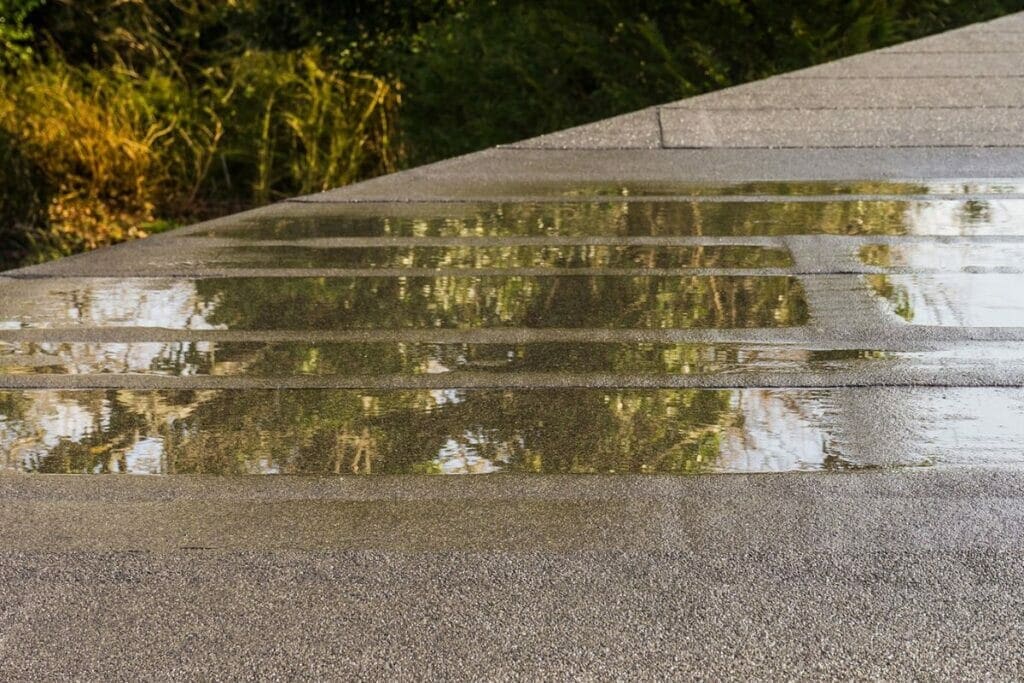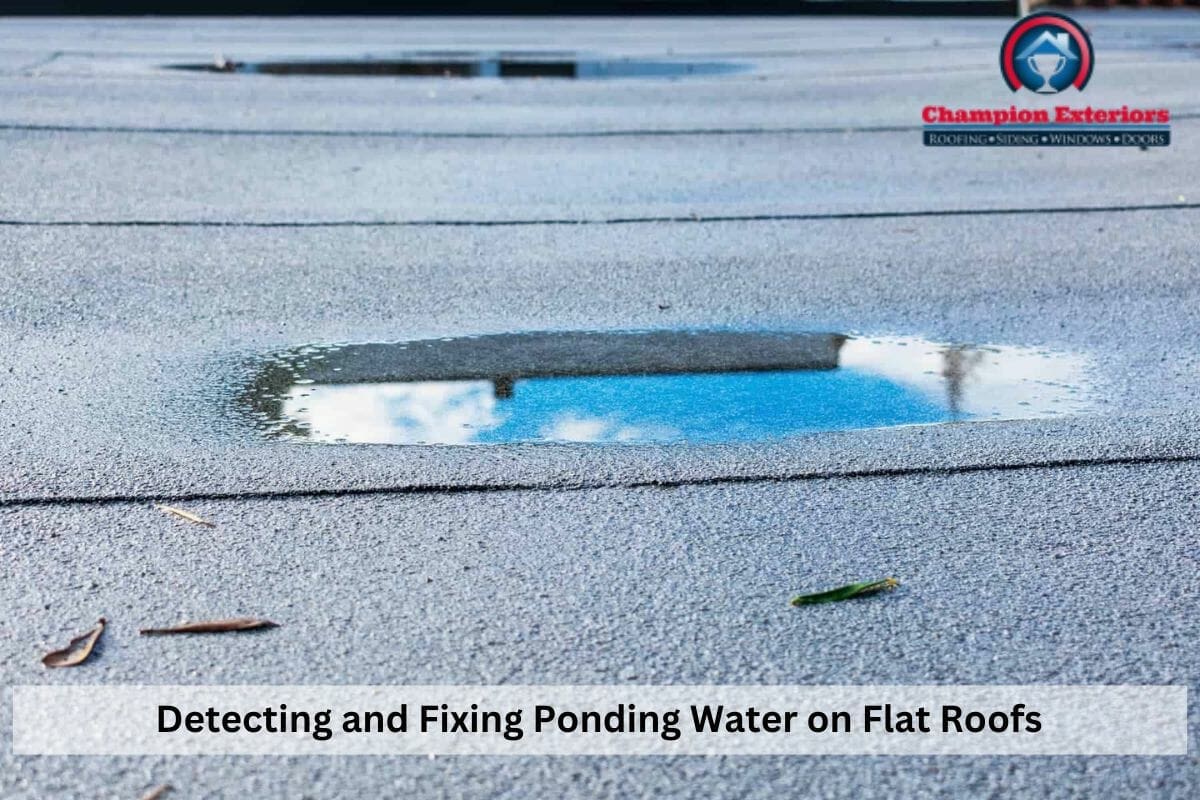Are you struggling with ponding water on the flat roof of your home or commercial property? You don’t have to struggle with it anymore. At Champion Exteriors, we aim to provide property owners with tips on how to protect the roof of their homes or businesses from damage, so we’ve provided a comprehensive article that will help you detect and fix the issue of ponding water. Continue reading to learn more!
Step 1: Detecting Ponding Water on a Flat Roof
Here are some signs to look out for that will help you detect whether or not there is ponding water on your roof.
1. Dark Stains on the Roof’s Surface
Dark stains on flat roof membranes are after-effects of ponding water. If you see dark stains on your TPO or white EPDM roof, it is a tell-tale sign of water ponding on your roof. Black stains are usually caused by algae growth, which is generally less likely to harm your roof, but can reduce its aesthetic appearance. Dark stains may also indicate a need for leak repairs and further inspection for potential damages caused by ponding water on your roof.
2. Water Stains on the Ceilings and Walls

Detecting ponding water on a flat roof can often begin with noticing water stains on your interior ceilings or walls. These stains serve as a warning sign that water may be accumulating on the roof and infiltrating the building’s structure. When water pools on a flat roof for an extended period, it can seep through roofing materials and the roof deck, leading to potential damage and costly repairs. By keeping an eye out for interior water stains, property owners can identify the presence of ponding water on their flat roofs and take the necessary steps to address the issue before it escalates.
Also, read – 7 Most important things to Know about flat roofs.
3. Mold and Algae Growth
Mold and algae stains can serve as valuable indicators of ponding water on a flat roof. When water accumulates and remains stagnant for extended periods, it creates an ideal environment for mold and algae growth. These organisms thrive in damp conditions, so their presence on a roof is a strong signal that water is not draining effectively. By observing mold and algae stains on the surface of a roof, property owners can detect potential ponding water issues early on. Taking timely action to address these problems can help prevent further damage to the roofing materials and the building’s structure, ultimately safeguarding the property and its occupants.
4. A Sagging Roof Deck
A sagging roof deck is a key indicator of ponding water on your flat roof. When the roof’s surface becomes uneven and dips in certain areas, it may be due to excessive weight, design flaws, or previous water damage. This unevenness can cause water to pool, potentially leading to further leaks, damage, and structural failure. The standing or stagnant water on a flat roof further increases the weight of the structure. If this additional load surpasses the roof’s weight limit, it can cause the surface to sag, forming dips where rainwater is more likely to accumulate and pond. By observing a sagging roof deck early on, property owners can detect potential ponding water issues and take appropriate action to prevent further damage.
Step 2: Identifying The Cause of Ponding Water
Here are some of the reasons that ponding water may have occurred on your roof. By knowing the causes, you can create solutions to prevent the problem from happening again.
Insufficient Drainage and Slope
One of the primary causes of ponding water on a flat roof is inadequate drainage and slope. A well-designed flat roof should have a slight slope to guide water toward the drains and prevent standing water. Over time, however, the slope may become compromised due to settling or shifting of the building, leading to inadequate drainage. Consequently, water may pool and stagnate on the roof, causing damage to roofing materials and potentially leading to leaks and other structural issues. Regular inspection and maintenance of the drainage system and slope can help prevent ponding water on a flat roof.
2. Debris Accumulation
Another common cause of ponding water on flat roofs is the accumulation of debris, such as leaves, branches, and dirt. These materials can obstruct the roof’s drainage system, preventing water from flowing freely off the roof. As water becomes trapped, it can lead to ponding and eventual damage to the roof’s structure and materials. To avoid this issue it’s essential to conduct routine cleaning and maintenance to remove debris and ensure proper drainage of the roof.
3. Damaged or Aging Roofing Materials
Ponding water can also result from damaged or aging roofing materials. As roofing materials age, they may become less effective at repelling water and maintaining a watertight seal. This can lead to low spots or depressions on the roof’s surface, where water accumulates and remains stagnant. Regular inspection of the roof’s condition and timely repair or replacement of damaged or worn materials can help prevent ponding water and extend the life of the roof.
4. Structural Issues
Structural problems, such as sagging roof decks or weakened support beams, can also contribute to ponding water on a flat roof. These issues may arise from excessive weight on the roof, design flaws, or damage caused by water or other external factors. As the roof’s structure becomes compromised, it may create low spots or depressions where water can pool and cause further damage. Addressing structural issues promptly and ensuring the roof’s support system remains in good condition can help prevent ponding water and maintain the roof’s overall integrity.
Step 3: Fixing Ponding Water on Flat Roofs

Now that you know what causes ponding water on a flat roof, here are some solutions to prevent it from occurring again, and damaging your property.
1.Regular cleaning and maintenance
To prevent a blocked drainage system, schedule regular cleaning and maintenance for your flat roof. Clearing away leaves, branches, dirt, and other debris will ensure the drainage system remains unobstructed and allows water to flow freely off the roof. Establishing a routine maintenance plan can help detect and address minor problems before they become significant issues, ultimately extending the life of the roof and preventing ponding water.
2. Repair or replace damaged roofing materials
To prevent ponding water caused by damaged or deteriorated roofing materials, conduct regular inspections to assess the condition of your roof. Identify any worn or damaged areas that may be contributing to low spots or depressions on the roof surface. Work with a roofing professional to repair or replace these materials as needed, ensuring a watertight seal and proper water drainage. Timely intervention and prompt repair on flat roofs can help prevent ponding water and extend the life of your flat roof.
3. Address structural issues
To tackle structural issues that lead to ponding water on a flat roof, it’s crucial to work with a qualified roofing professional. They can assess the roof’s support system, identify weaknesses, and recommend appropriate solutions. This may involve reinforcing support beams, correcting design flaws, or resolving other factors contributing to sagging or compromised roof decks. By promptly addressing structural issues, you can prevent ponding water, maintain the roof’s integrity, and protect your property from potential damage.
Hire The Professionals To Inspect or Repair Your Flat Roof.
Hiring trusted and skilled roofers is an important part of fixing ponding water on a flat roof. It will add value to your roof and give it a new life if it has experienced some sort of damage. As you now know, ponding water poses a significant threat to the integrity of your flat roof. If neglected, it can lead to more severe problems and increased expenses. Therefore, if you live in Hainesport or the surrounding area of New Jersey, call Champion Exteriors (609)845-3576 to repair your flat roof.


